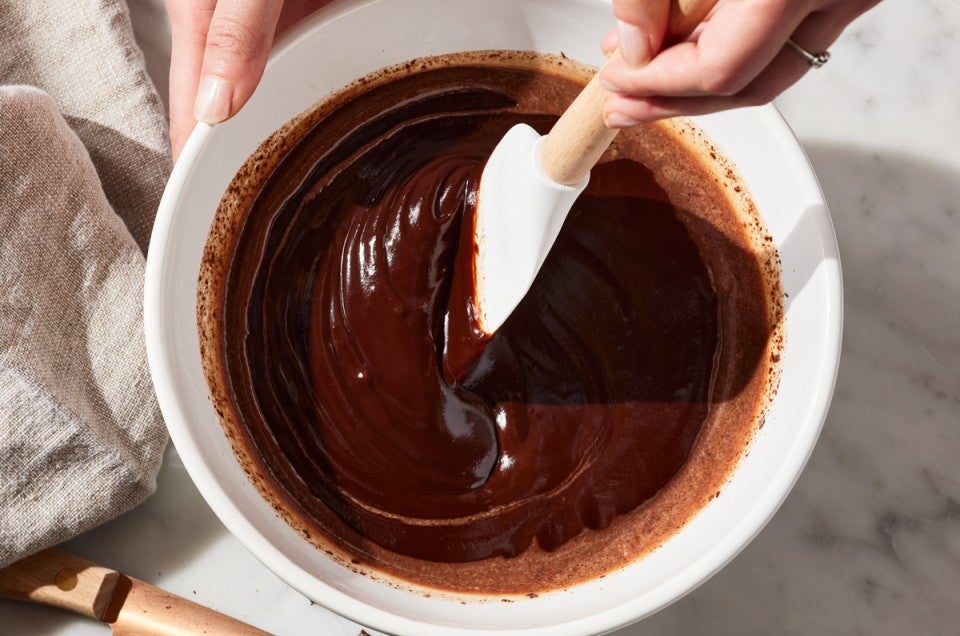


You’re stirring together ganache, that luxurious blend of hot cream and melted chocolate, and suddenly, it doesn’t look right. Instead of becoming smooth and creamy, it turns grainy. Or morphs into oily chocolate chunks. Can this ganache be fixed?
Absolutely. Almost any “broken” (or “split”) ganache can be resurrected with the addition of one simple ingredient. But first, let’s discover why ganache breaks — so that you can avoid this outcome going forward.
A classic ganache is made of just two ingredients: solid chocolate and heavy cream. Typically, chopped chocolate (dark or milk) and steaming-hot (about 180°F) heavy cream are combined in a heatproof bowl. After waiting five minutes or so for the chocolate to soften and partially melt, the mixture is stirred until completely smooth. That’s it. (Learn more about making great ganache here: How to make ganache.)
So what can go wrong? Chemistry.
When very hot (just below a simmer) cream is poured over chocolate, the mixture becomes a soft, pourable substance somewhere between solid and liquid. Physical chemistry defines this as an emulsion: a smooth blend of solid or semi-solid particles suspended in liquid, the solids broken down so much that they’re no longer detectable as their individual selves.
How does emulsification happen? In the familiar case of oil-and-vinegar salad dressing, rapid whisking or shaking breaks the oil (and other semi-liquids like mustard or honey) into tiny droplets that become suspended in the vinegar or other liquid, creating a smooth, thickened dressing.
In the case of ganache, though, it’s heat that breaks the chocolate into its component parts (sugar, fat, and cocoa solids). The sugar melts and joins the water in the heavy cream to create a liquid syrup, and this syrup holds tiny particles of milk protein and cocoa solids in suspension, plus droplets of fat: In other words, it becomes an emulsion.
Unlike sturdier emulsions, which often include stabilizers (think egg yolk in a vinaigrette dressing), ganache can be finicky. If something goes wrong, the emulsion “breaks” — and suddenly the fat, cocoa, and their liquid syrup disengage. The result? An oily, grainy, and/or globby ganache — in other words, nothing you’d want to drizzle over a cake or cool and shape into truffles.
There are two common reasons ganache breaks:
Too little liquid: Using chocolate with a very high percentage of cacao (above 70%; e.g., very dark bittersweet chocolate) means your ganache will have too little sugar (which melts to form liquid), and too much solid chocolate. The result: The solids crowd out the liquid, leaving the ganache thick, rough, and grainy.
This imbalance between solid and liquid can also happen if the percentage of heavy cream to chocolate is too low. One part cream to two parts chocolate, by weight (i.e., a ganache that’s 33% cream) will produce a thick ganache, one suitable for solid truffles or cookie fillings. Dipping below that percentage, especially if you’re using a high-cacao chocolate to begin with, can cause your ganache to break: There's simply too much solid chocolate and not enough liquid.
Too much heat: Maybe you decided to prepare your ganache in a saucepan on the stovetop, and let it come to a rolling boil. Or perhaps you tried to get rid of those last few bits of unmelted chocolate by reheating the mixture in the microwave.
Know this: Chocolate hates to be overheated! High heat first breaks apart and then forces together chocolate’s three elements — sugar, cocoa, and fat. Instead of calmly settling into a liquid emulsion, the cocoa and fat cluster in tight little groups, refusing to disperse. If you’ve ever made ganache that suddenly turns gloppy and oily, high heat is probably the villain.
A less common way to break ganache is to add cold heavy cream to hot or warm ganache in an attempt to thin it out. Cold turns the fat solid and encourages the cocoa particles to clump. If you want to thin your ganache, make sure the liquid you add is warm!
You’ll find any number of fixes for broken ganache online, from amateur and professional bakers alike. And most boil down to these two solutions:
If your ganache split because the liquid ratio was too low and the chocolate and cream became grainy and oily, stir in hot tap water (about 90°F to 95°F). Add the water gradually, starting with a teaspoon and whisking vigorously in between additions, until you see the ganache starting to become smooth and cohesive again. Continue to whisk until the mixture smooths out entirely, adding more hot water only as necessary.
If your ganache broke due to high heat, follow the same process: Add hot water a bit at a time, whisking vigorously all the while. In this second case, it might seem counterintuitive to add hot water; isn’t heat what got you into trouble in the first place? But it works: Just that small amount of added water gives the chunks of cocoa and fat globules space to maneuver. They quickly disperse into the syrup and sink back into a happy emulsion. The result: perfectly smooth ganache.
We like this water fix because it doesn’t add any fat to the ganache. A broken ganache is already struggling with prone-to-clump fat globules; why add fuel to that fire, when what you’re looking for is simply more liquid? Sometimes, the simplest solution really is the best one.
Now that you know how to handle ganache, check out some of our favorite recipes using it: Macarons, Chocolate Caramel Cake with a ganache drizzle, and Decadent Chocolate Truffles.
Cover photo by Mark Weinberg; food styling by Liz Neily.